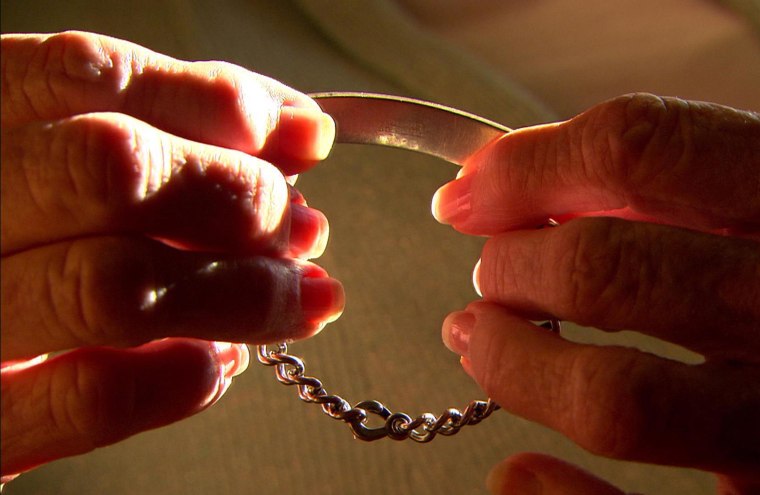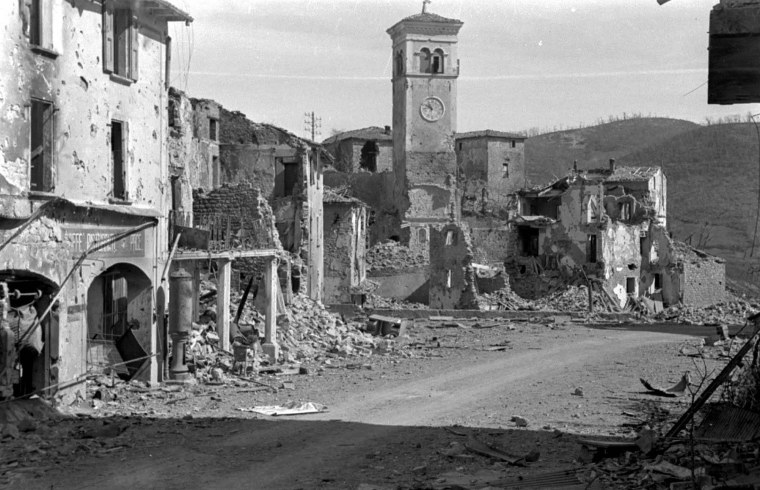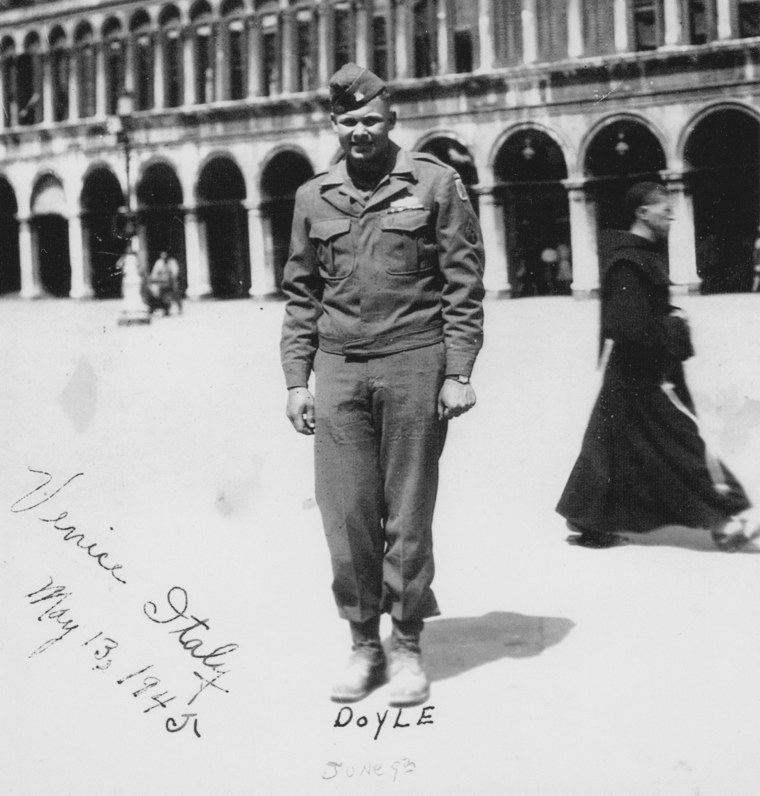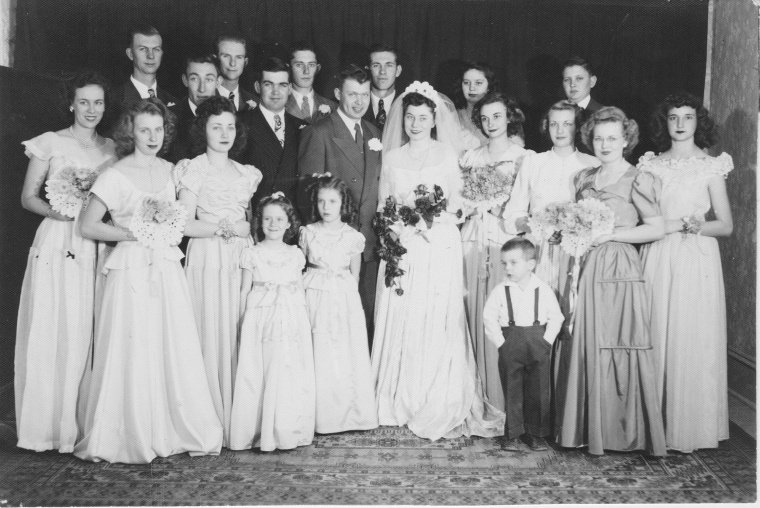Warren McCauley was a war hero, a recipient of the Bronze Star who helped push Germany out of Italy in 1945. His silver identification bracelet came off somewhere amid 114 days of bloody progress, peak to peak, through the mountains of Tuscany.
It didn’t stay where it fell.
Three days before Christmas, almost exactly 70 years after McCauley lost the bracelet, a group of his relatives gathered in Orange County, California and watched as his widow pulled the ties on a small red pouch. It had just arrived from Italy and the 85-year-old reached in with two trembling fingers.
"It’s unreal to hold it now," said Twila McCauley, gazing at the 7-inch chain and small plaque. “It’s just so amazing.”
She took a seat by a window and closed her eyes, running her fingers over the worn name and serial number of her late husband.
“Oh Lord,” she said. “What are you trying to tell us?”
The silver bracelet's long journey home is a story of luck, technology, and the spooky power of artifacts, especially those carried in war. NBC Nightly News was able to tell it for the first time, drawing on military records, the work of historians, and the memories of McCauley's family.

It began when McCauley joined the Army and his family—farmers from Stockton, Kansas—gave him the silver bracelet as a gift. It was a fashionable choice at the time but also practical. Nearly 300 Americans a day were dying in modern, mechanized combat. Here was a way to help identify their bodies.
McCauley didn’t seem like much of a soldier, a 19-year-old trombone player with a mega-watt smile. But the Army liked his mind. It schooled him in the fledgling science of radio and sent him into the Rocky Mountains to perfect it.
He joined Camp Hale, staging ground for what would become the 10th Mountain Division, an elite new alpine unit. The idea followed the Soviet invasion of Finland, where soldiers on skis shredded two Russian tank divisions, embarrassing Moscow, and inspiring Washington.
The Pentagon partnered with the American Alpine Club and the National Ski Patrol, recruiting some of the finest winter athletes in America, and sending them to Camp Hale for a coat of armor.
McCauley's big test came in early 1944, when he and thousands of other men fought a mock battle and slept in the snow. For six weeks the teams weren’t allowed to make fires, even when temperatures fell below zero. Hundreds of men quit. The rest got on a boat to Italy.
McCauley’s regiment arrived on the Tuscan coast in January of 1945, along with most of the 10th Mountain Division, more than 10,000 men in all. They headed straight for the Apennines range, watchtowers of the German defense. In the last year, thousands of Americans had died trying to break the line.
Only the 10th prevailed. They destroyed five German divisions in three months, and McCauley helped launch one of the first major counteroffensives, according to an Army press release issued later that year.
After a German patrol sliced some of his communication lines, the young corporal advanced under “a hail of small arms fire” to restore communication, an act of “undisputed heroism,” the Army said.
As McCauley’s division rolled northward they made only one significant stop, resting in a shattered crossroads town called Castel D’Aiano. They entered in March, moved out in early April, and drank cognac and champagne when the German's surrendered that May.
McCauley’s silver bracelet didn’t move with them.

Melancholy treasure
Bruna de Maria was a child when the Americans arrived in Castel D’Aiano, hollow-eyed and mangled, hoping for a home-cooked meal and their first baths in weeks. She screamed at the sight of them.
“What do you expect from an 8 year old?” she said recently, speaking through a translator. “But the Americans, they had a big heart.”
“I was very poor, so a bracelet for me was a treasure.”
Her father hung a white sheet, a signal that the de Maria home was open for use as a field hospital and canteen. Her mother, older sister, and grandmother worked both, as little Bruna looked on happily, her face stained with American chocolate.
Within weeks de Maria was afraid again.The Americans were gone and her father was dead, killed by a German land mine. That’s when she saw the bracelet, sitting in a glass-front cabinet in her home.
McCauley might have left it as a tribute, or a tip, or a form of payment for care. He might have simply forgotten it. Or lost it on the land nearby. No one can say for sure.
But de Maria remembers its allure.
“I just took it,” she said. “I was very poor, so a bracelet for me was a treasure.”
But this was a melancholy kind of treasure, a remembrance of the war and its many departed heroes. She never wore the bracelet or contemplated selling it. Instead she cleaned and cared for the bracelet, keeping it in her bedside table for reasons she can’t readily explain.
“I always asked myself, who does it belong to? But I never tried to find the man,” she explained. “It almost felt as if it were mine.”
Her son Stefano Sedda felt differently from the moment he first held the relic in September.
“This bracelet made history,” he explained recently, speaking through a translator. “It belonged to an American soldier who came her to fight, to defend our country—that’s why I thought of giving it back.”
He tried the internet, but he mistook the maker of the bracelet for the owner of the bracelet. A search for "Stuart Sterling" came up empty. He gave that same name to the American consulate in Milan, but they said they couldn’t trace a soldier for him.
That's where the case of the lost silver bracelet might have rested if not for luck. Stefano showed the bracelet to a dinner guest. The guest sent a picture of the bracelet to a cousin in Oklahoma, a lawyer named Carolyn Thompson.
The lawyer tried a journalist at NBC News, who tried Dennis Hagen, the official archivist for the 10th Mountain Division. His private search by the number of the bracelet produced a name, Warren D. McCauley, which lead to a last known address, in Buena Vista, California, and a woman named Twila, now 85.
“I’m about to hit the floor,” she said, when a reporter first called about the silver bracelet. “You know the Lord, He is really there—have you ever felt him close? I can feel him now.”
Back in the family
Warren McCauley came home in August of 1945 and by the following spring he was at Kansas State University. He played his trombone, and pushed ahead, believing that forward momentum was good for the soul.

He met Twila that summer, an 18-year-old clarinet player in a small town parade. He married her the next winter and became a father soon after. He worked as a music and math teacher and rarely spoke of the war, except self-deprecatingly.
In one story his mule tipped him into a river. In another a town of grateful Italians tossed loaves of bread so stale they nearly cracked his windshield. Many soldiers wore rings, tags, and bracelets after the war to signal their service. But Warren McCauley never talked much about what he was lacking.
“I wish he had talked more,” said Twila. “You wonder what else he could have told us.”
He died at home in 1986, suffering a heart attack in the family room. "I'm fine," he told Twila, who offered to get him some water. The next thing she knew he was gone.
"He just had that great big beautiful smile," she said, "and I remember him that way."
But now the silver bracelet is bringing more of him back, providing his three kids, five grandkids, and six great-grandkids a rare physical link to a war zone.
“I feel very emotional about it,” said Dee Prophet, Warren’s eldest daughter. “It’s a piece of him that we can all share, and treasure and have back in the family.”
“We just are so thrilled that they cared enough, and loved that bracelet, and took care of it with love,” added Twila McCauley, thinking about their new Italian side of the family. “That’s a special memory for us now too.”
Bruna de Maria and her son Sedda agree.
“This closes the circle,” he said, as he sent the silver bracelet on its way to America. “Now it goes home.”
